Current Features
Dinner Is Served
Health and nutrition, convenience and choice drive innovation in today’s food services
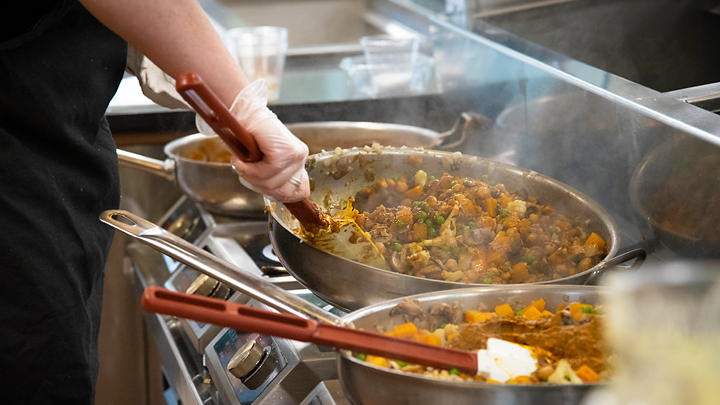
By Tom Woolf
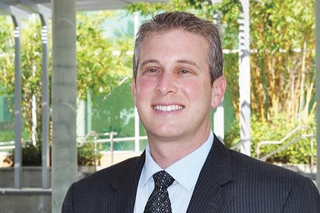
David DiSalvo, resident district manager for Aramark/USF Dining, has had a front-row seat to dramatic changes in dining on university campuses during his 16 years in hospitality services in higher education.
“The days of cafeteria food are long gone,” says DiSalvo, who has been in his role with USF Dining the past six years.
Students reflect societal trends and also serve as a predictor of the future of dining.
“More than anything, populations in higher education are really good peeks under the curtain as to where things are headed,” he says. “Our customers – students – are sophisticated. They have sophisticated means of accessing information, such as smart phones, and as responsible providers, institutions have to align with that demand. Shifts in dining generally are most evident in higher education.”
Traditional campus cafeterias have been replaced by a variety of innovations, including rotating menus, a Flip Kitchen, True Balance and mobile ordering. The priorities for today’s students are health and nutrition, convenience and choice.
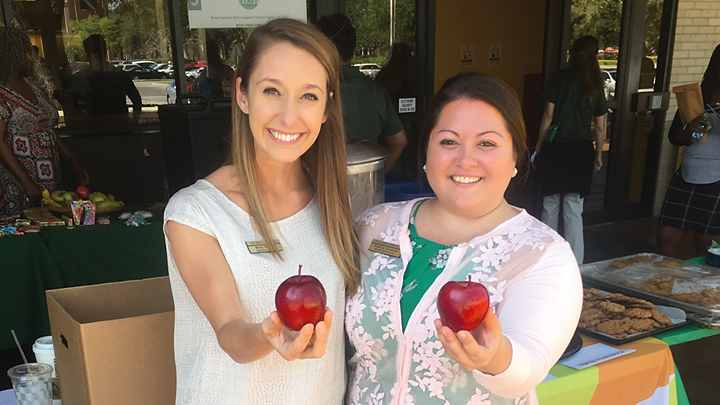
Jessica Cicalese ’11, marketing director for USF Dining – and a registered dietitian – can attest to how much has changed in just the eight years since she was an undergraduate.
“When I was a student, there were far fewer dining options. Today, we have more than 30,” she says. “We have three all-you-care-to-eat dining halls, designated vegan stations and an allergen station. We have many different populations at USF and we want to make sure we have something for all nationalities and cultures.”
USF Dining’s locations range from the Top of the Palms at the Marshall Student Center to popular retail outlets, including Starbucks, Einstein Bros. Bagels, Burger Fi, Subway, Jamba Juice, Pollo Tropical, Chick-fil-A, Wicked Eats by Cat Cora and local Bay Coffee & Tea Company. A makeover of the food court in the Marshall Student Center is taking place this summer, and new options will include Panera Bread, Bento Sushi, a hot ramen bar and a salad bar. USF Dining also caters events across campus throughout the year.
By way of comparison, during the 2000-01 academic year, students, faculty and staff had 12 campus options, including Crossroads Café, Café Good Eats, The Corner Grocery, Good Stuff, etc., and Firehouse Grill. Some alumni may recall USF’s first food service provider, Morrison’s Cafeteria, and its lone dining hall in USF’s first student union, the University Center.
Philadelphia-based Aramark has been the university’s food service partner since 2002. The company, which provides dining services on more than 300 college and university campuses across the country, recently signed a new 10-year contract with USF.
“The relationship with Aramark has been fantastic,” says Nancy Santiago, director of USF Auxiliary Services. “There is a big focus on healthy, sustainable initiatives and that aligns with our university’s mission.”
She credits DiSalvo and his team with “constantly looking to move the needle” based on sound research.
“We leverage the fact that as a large corporation, they can handle the market research. They have a methodology to do certain research analyses to determine what’s the right fit for each university,” Santiago says. “They look at concepts and at what USF needs.”
They also actively engage with students.
“USF Dining does a good job of listening to our students,” Santiago says. “The fact that they actively engage with our university community and positively react to the feedback is one of the many reasons as to why I’m so happy with our partnership.”
For example, when it became clear that sushi is a popular option among students, USF Dining installed a sushi machine from Japan in one of the dining halls.
Representatives of USF Dining meet with the 80-member Residence Hall Association (RHA), which doubles as a dining advisory council, on a monthly basis during the academic year. Sixteen residence hall councils, along with an executive board, comprise the RHA.
Evan Collins, an education major from Honolulu, is president of the RHA.
“We appreciate the fact that Dining welcomes an open conversation,” he says. “Our relationship is very positive, very constructive.”
Adds J.D. Salazar, a public health major from Altamonte Springs, Fla., and RHA vice president, “We get to see the people who make the decisions. We see them implement changes that we recommend.”
Students enjoy the variety of options available, the convenience, and the focus on health and nutrition. There’s a social aspect as well, particularly in the dining halls, and students appreciate the relaxed atmosphere.
Asked what more USF Dining could be doing to accommodate students, Collins pauses.
“Just the fact that I have to think for a long time about the need for any improvements is a statement in and of itself,” he says.
DiSalvo notes that the university and USF Dining share the goal of building community.
“This is the students’ home, and we take that very seriously,” he notes. “We want people to feel welcome and included. Everybody breaks bread; that’s how you bring people together. We understand that and leverage that in our programming decisions.”
Weekly dining events are among the initiatives that help bring students together. Wing Wednesdays proved to be “wildly popular” at one of the dining halls during the spring semester, Cicalese says. Examples of other sponsored events include National Cappuccino Day, National Greek Yogurt Day and National Nacho Day.
Building community also means being socially responsible. Since March 2017, USF Dining has donated more than 1,200 pounds of fresh produce and Einstein Bros. bagels to the Feed-A-Bull food pantry. Among other initiatives, plastic straws have been removed from several key locations, including the Marshall Student Center. The Sip Smarter Campaign will expand to all retail locations across campus in the 2019-2020 academic year. Aramark research shows that 94 percent of Generation Z’ers (born between the mid-1990s and mid-2000s) believe companies should help address social and environmental issues.
With its 30-plus dining halls and retail outlets, USF Dining is a major campus employer, with 1,300 associates. More than half are students.
“Many student employees become leaders for us,” DiSalvo says. “USF is one of the top recruiting schools for Aramark both in the U.S. and internationally. The student engagement piece benefits our organization and of course, students. There’s nothing like being served by a peer. That has a level of authenticity to it. Feedback flows more freely and that helps us adjust as needed.”
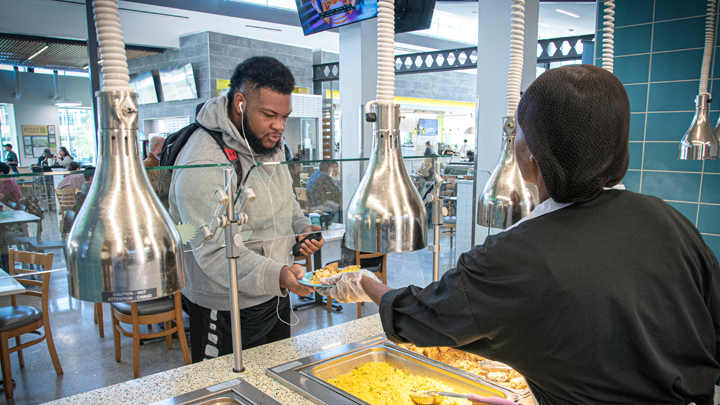
Across all of its locations, USF Dining serves 20,000 meals a day during the academic year. Of that total, approximately 5,000 a day are dished up at the Hub, which opened in 2017 at The Village residence hall complex. Students, faculty and staff can choose from nine stations, including globally inspired entrees, pizza, deli offerings, salads, desserts and Italian specialties.
“The Hub is an accumulation of a lot of years of learning and mistakes,” DiSalvo says, referring to USF Dining’s ongoing research into college dining trends. “The Hub is a great space that not only incorporates technology and the most cutting-edge trends, it’s breathable. It expands when demand dictates, but it also contracts. Most of us eat in a certain time frame for a sit-down meal. The Hub needs to expand at traditional peak times but contract efficiently because there are always people who are hungry.”
USF Dining Services devoted two years to designing and “gathering the best of the best from around the country” for the Hub.
“We have flexibility for future growth,” DiSalvo says. “Equipment choices, power, data, all the things in that space can behave well for five years and for up to 15-20 years. Whatever is the next best thing easily can find a home there.”
USF is one of the few universities in the country to feature the Aramark-branded True Balance kitchen, which has proven to be a big draw at the Hub. The kitchen is isolated from the other stations so it remains free of seven of the top eight food allergens.
“It offers a lot of lean protein and vegetables,” DiSalvo says. “It gives people some piece of mind while introducing the broader population to healthier eating.”
Adds Cicalese: “It puts students and their parents at ease. It’s one of our most popular stations, even for those without allergies and dietary needs.”
USF Dining’s emphasis on building community is integral to Argos Exchange, which also opened in the fall of 2017. While similar to the Hub in that it also is a multi-concept venue, Argos is a la carte, rather than all you can eat.
“Argos is a community building that happens to have food inside,” DiSalvo says. “If you want to come in to collaborate, do that. If you want to come in to hang out, do that.”
Argos also features a demonstration kitchen, where USF Dining’s chefs demonstrate meal preparation for students and share recipes.
New concepts are constantly in development. USF Dining is slowly introducing campus bicycle deliveries, which are directed especially toward faculty and staff. Orders are placed using the Tapingo mobile app on a smart phone. In addition, mobile ordering through the Tapingo app – already in use at most dining locations – will be available in the Marshall Student Center, where long lines are a regular occurrence during lunch hours. So much so, Cicalese notes, that “a heat mapping exercise we performed to see the traffic during the noon hour showed you can’t move” in the food court.
“Personalization and convenience are key,” DiSalvo says of campus dining in the 21st century. “Health is at the pinnacle of what we use to make decisions.”
What's On The Menu?
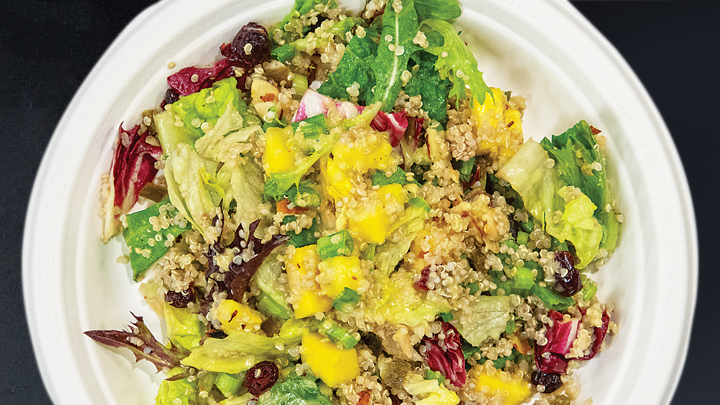
Vegan. Vegetarian. Plant-forward. Flexitarian. Food allergies.
Keeping up with the dietary needs of thousands of USF students may seem daunting, but not to Mary Waddill.
USF Dining’s registered dietitian for the past two years, Waddill embraces her many opportunities to help educate students about food – and about cooking.
“A big piece of my job is outreach, such as hosting tabling events, providing nutrition education presentations or conducting cooking demonstrations, which I do on a weekly basis,” she says. “With cooking demonstrations, I try to focus on making cooking doable, easy, helping students learn how to prepare a balanced meal.”
There is no question that today’s students have a much sharper focus on healthy eating. A USF Dining survey shows that 62 percent of students want to eat more vegetables; 60 percent want to reduce meat consumption; and 42 percent would try new plant-based foods. In response, vegetarian and vegan selections now make up 30 percent of USF Dining’s menus.
According to peta2’s 2018 Vegan Report Card, two-thirds of the nation’s colleges and universities now offer vegan meals on campus. The organization, a youth animal rights group and a subset of PETA (People for the Ethical Treatment of Animals), has surveyed university dining programs for the past five years.
For the third year in a row, USF earned an “A+” on the annual report card.
“As a whole, the culture around food is transitioning,” Waddill says. “The idea behind plant-forward eating, specifically by making plant-based foods like fruits, vegetables, legumes and whole grains the focus of your meals. That approach is more encompassing than a vegan or vegetarian diet.”
According to Aramark, USF’s food service partner, 85 percent of college students nationally are likely to order plant-forward meal options. Top choices include Southwestern salad, hummus bowl, fajitas, lasagna with vegetables and veggie/bean burger.
As is the case at many universities, a “flexitarian” diet also is a growing trend at USF.
“You may choose a vegan diet one week, then try something different the next week,” explains Jessica Cicalese ‘11, USF Dining’s marketing director who also is a dietitian. “Students are experimenting with different diets that focus more on plant proteins.”
In addition to nutrition education sessions and weekly cooking demonstrations, Waddill regularly meets with individual students. She calls those one-on-one counseling opportunities “a great amenity” for students.
“I meet with at least one student a day,” she says. “We discuss food allergies, how to navigate the dining halls, how to lose weight, or how to build muscle. I also debunk a lot of fad diets. Students appreciate having an evidence-based resource rather than just relying on what’s on the Internet. I try to provide them with information to allow them to make their own healthier choices, because every student has different needs.”
Waddill also created a QR Code that provides students with all macro and micro nutrient information for residential menus with one scan on a smartphone.
“Students really want the education about how eating affects their health,” Cicalese says.
Recipes To Make At Home
Mango Quinoa Salad
Ingredients:
½ cup romaine lettuce
½ cup mixed greens
1 cup quinoa
½ cup fresh mango, diced
1 tbsp green onion, sliced
2 tbsp almonds, sliced and toasted
2 tbsp dried cranberries
1 cup Tropical Ginger Vinaigrette
Tropical Ginger Vinaigrette:
½ cup pineapple
2 tbsp rice wine vinegar
2 tbsp orange juice
1 ½ tsp lemon juice
1 ½ tsp sugar
1 ½ tsp gingerroot
1 ½ tsp cilantro
½ tsp garlic
1/8 tsp salt
1 pinch cayenne pepper
¼ cup olive oil
Directions:
To prepare tropical ginger vinaigrette, combine all ingredients in blender or food processor, except oil. Blend until smooth.
With blender running, slowly add oil in a thin, steady stream until emulsified.
In a bowl, combine romaine lettuce, mixed greens, quinoa, mango, jalapeno, scallion and tropical ginger vinaigrette dressing. Top with toasted almonds and cranberries. Enjoy!
Makes 4 servings, 330 calories each
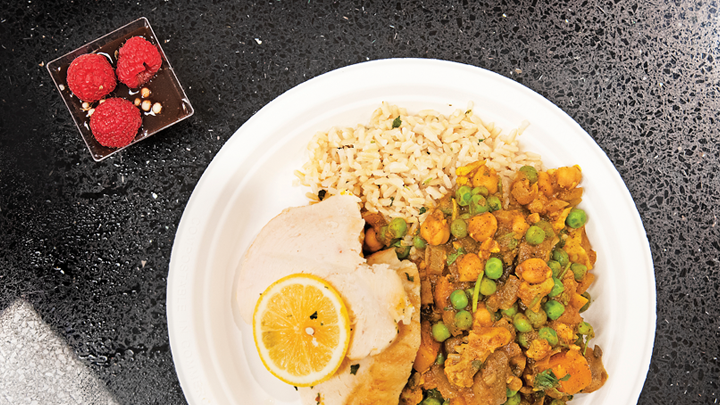
Aquafaba Chocolate Mousse
Ingredients:
1 tbsp coconut milk (unsweetened)
½ cup semisweet chocolate
½ cup reserved garbanzo bean liquid
2 pinches cream of tartar
2 tbsp granulated sugar
Directions:
In top of double boiler, over hot (not boiling) water, heat coconut milk. Add chocolate.
Stir until chocolate is melted and smooth. Remove from heat.
In a mixer bowl with whisk attachment, beat reserved bean liquid and cream of tartar on medium-high speed until foamy, 5 minutes. Gradually add sugar, beating until stiff peaks form.
Add 1/3 of the whipped mixture to the melted chocolate. Whisk until well blended.
Gently fold remaining whipped mixture, one half at a time.
Into each of the four dessert dishes, portion in chocolate mixture.
Cover and refrigerate overnight.
Keep chilled for service and enjoy!
Makes 4 servings
230 cal per each
Pumpkin-Curry Vegetable Sauté
Ingredients:
½ cup cauliflower
½ cup mushrooms
½ cup garbanzo beans
½ cup green peas
½ cup blanched butternut squash
½ cup yellow onion
¼ cup & 1 ½ tbsp canned pumpkin
3 tbsp water
½ tsp low sodium vegetable base
½ tsp ginger root
1 tsp curry powder
1/8 tsp chili powder
1/8 tsp black pepper
1/8 tsp turmeric
¼ tsp salt
2 tsp olive oil
1 tbsp garlic
1 tbsp cilantro
2 cup cilantro brown rice
Cilantro Lime Brown Rice
Ingredients:
1 1/3 cup water
2 tsp lime juice
1 tbsp low sodium vegetable base
2 pinches black pepper
¾ cup brown rice
1 1/2 tsp cilantro
Directions:
For cilantro-lime brown rice, in stockpot over high heat, bring water, lime juice,
base and pepper to a boil. Add rice and stir. Return to a boil. Reduce heat and cover.
Simmer rice until water is absorbed, about 20-25 minutes.
In stockpot over medium-high heat, combine pumpkin, water, lemon juice, base, ginger root, curry powder, chili powder, pepper and ground turmeric. Cook, stirring constantly until sauce is hot, 3 to 5 minutes.
In sauté pan, heat oil. Add onion, garlic and cauliflower. Stir-fry until tender-crisp, 2 to 3 minutes.
Add mushroom. Stir-fry 3 minutes.
Add garbanzo beans, frozen peas, butternut squash, salt and pumpkin sauce. Bring to a boil. Reduce heat. Simmer 2 minutes.
On serving plate, layer brown rice, vegetable mixture and 1 tsp cilantro. Enjoy!
Makes 4 servings
250 cal per serving
Recipes courtesy of USF Dining